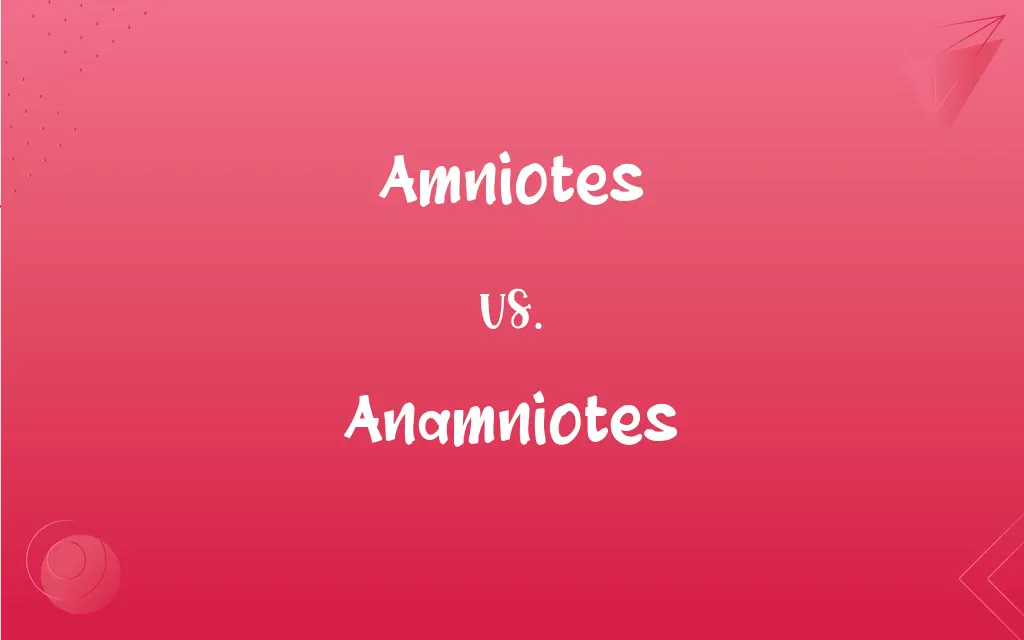Amniotes vs. Anamniotes: What's the Difference?
Edited by Aimie Carlson || By Harlon Moss || Published on February 5, 2024
Amniotes are vertebrates with an amniotic egg, characteristic of reptiles, birds, and mammals, whereas anamniotes lack this egg and include fish and amphibians.

Key Differences
Amniotes, which include reptiles, birds, and mammals, possess an amniotic egg that allows them to reproduce on land. Anamniotes, such as fish and amphibians, lack this egg, relying on water for their reproductive processes.
The amniotic egg of amniotes contains membranes that protect and nourish the embryo, adapting them for a terrestrial lifestyle. In contrast, anamniotes reproduce in aquatic environments, where external fertilization often occurs.
Amniotes have evolved various adaptations for terrestrial life, including waterproof skin and advanced respiratory systems. Anamniotes, on the other hand, are typically more dependent on aquatic habitats, with skin that often requires moisture.
In amniotes, the development of the embryo happens within the protective amniotic sac, reducing dependency on water for development. Anamniotes usually have a life cycle that involves a larval stage, which occurs in water.
The evolution of the amniotic egg in amniotes represents a significant divergence in vertebrate evolution, leading to greater diversity in terrestrial habitats. Anamniotes, while diverse, are more restricted in their ecological niches due to their reliance on aquatic environments for reproduction.
ADVERTISEMENT
Comparison Chart
Egg Type
Amniotic egg
No amniotic egg
Representative Groups
Reptiles, birds, mammals
Fish, amphibians
Reproduction
Mostly independent of water
Dependent on aquatic environments
Adaptations
Terrestrial adaptations (e.g., waterproof skin)
Aquatic or semi-aquatic adaptations
Development
Embryo develops within the amniotic sac
Often have a larval stage in water
ADVERTISEMENT
Amniotes and Anamniotes Definitions
Amniotes
Amniotes are adapted for life on land.
Mammals, as amniotes, have adaptations that allow them to thrive in terrestrial environments.
Anamniotes
Anamniotes are vertebrates without an amniotic egg.
Fish, as anamniotes, lay eggs that do not have protective amniotic layers.
Amniotes
Amniotes are vertebrates with an amniotic egg.
Birds are amniotes, as they lay eggs with protective amniotic membranes.
Anamniotes
Anamniotes include fish and amphibians.
Anamniotes like frogs undergo metamorphosis from aquatic tadpoles to terrestrial adults.
Amniotes
Amniotes include reptiles, birds, and mammals.
The diversity of amniotes is evident in the range from lizards to humans.
Anamniotes
Anamniotes reproduce in aquatic environments.
Salmon, an example of anamniotes, return to rivers to spawn.
Amniotes
Amniotes have a distinct embryonic development.
In amniotes, the embryo develops within a specialized protective sac.
Anamniotes
Anamniotes have adaptations for aquatic or semi-aquatic life.
The gills of fish, which are anamniotes, are essential for breathing underwater.
Amniotes
Amniotes are characterized by waterproof skin and advanced respiration.
The scaly skin of reptiles, a group of amniotes, exemplifies their adaptation to dry habitats.
Anamniotes
Anamniotes often have a life cycle with a larval stage.
Amphibians, as anamniotes, typically start life as water-bound larvae.
Amniotes
Any of numerous vertebrates of the group Amniota, characteristically having an amnion during embryonic development and including the reptiles, birds, and mammals.
Anamniotes
Plural of anamniote
Amniotes
Plural of amniote
FAQs
What defines an amniote?
Vertebrates with an amniotic egg.
What are anamniotes?
Vertebrates lacking an amniotic egg.
Do amniotes lay eggs?
Most do, except for most mammals which give birth to live young.
Are all mammals amniotes?
Yes, all mammals fall under amniotes.
What is the reproduction method of anamniotes?
Typically external fertilization in water.
Can amniotes live in water?
Some can, but they're primarily adapted for land.
Are all fish anamniotes?
Yes, all fish are categorized as anamniotes.
Do anamniotes have any terrestrial adaptations?
Some do, especially amphibians, but they're closely tied to water.
How do amniotes reproduce?
Mostly on land, with internal fertilization.
What's a key evolutionary trait of amniotes?
The development of the amniotic egg.
Are birds considered amniotes?
Yes, birds are a type of amniote.
What's a distinctive feature of anamniotes in reproduction?
Their reliance on water for spawning.
Do amniotes have scales?
Many do, like reptiles, but not all.
Are there anamniote mammals?
No, all mammals are amniotes.
Where do anamniotes mostly live?
In aquatic or moist environments.
What is the skin texture of most anamniotes?
Typically smooth and moist, especially in amphibians.
Can anamniotes breathe air?
Some, like amphibians, can breathe air and water.
Do anamniotes undergo metamorphosis?
Many, especially amphibians, undergo metamorphosis.
How do amniotes breathe?
Through lungs, and some also have secondary methods.
What is the habitat of most amniotes?
Varied, but primarily terrestrial.
About Author
Written by
Harlon MossHarlon is a seasoned quality moderator and accomplished content writer for Difference Wiki. An alumnus of the prestigious University of California, he earned his degree in Computer Science. Leveraging his academic background, Harlon brings a meticulous and informed perspective to his work, ensuring content accuracy and excellence.
Edited by
Aimie CarlsonAimie Carlson, holding a master's degree in English literature, is a fervent English language enthusiast. She lends her writing talents to Difference Wiki, a prominent website that specializes in comparisons, offering readers insightful analyses that both captivate and inform.






































































